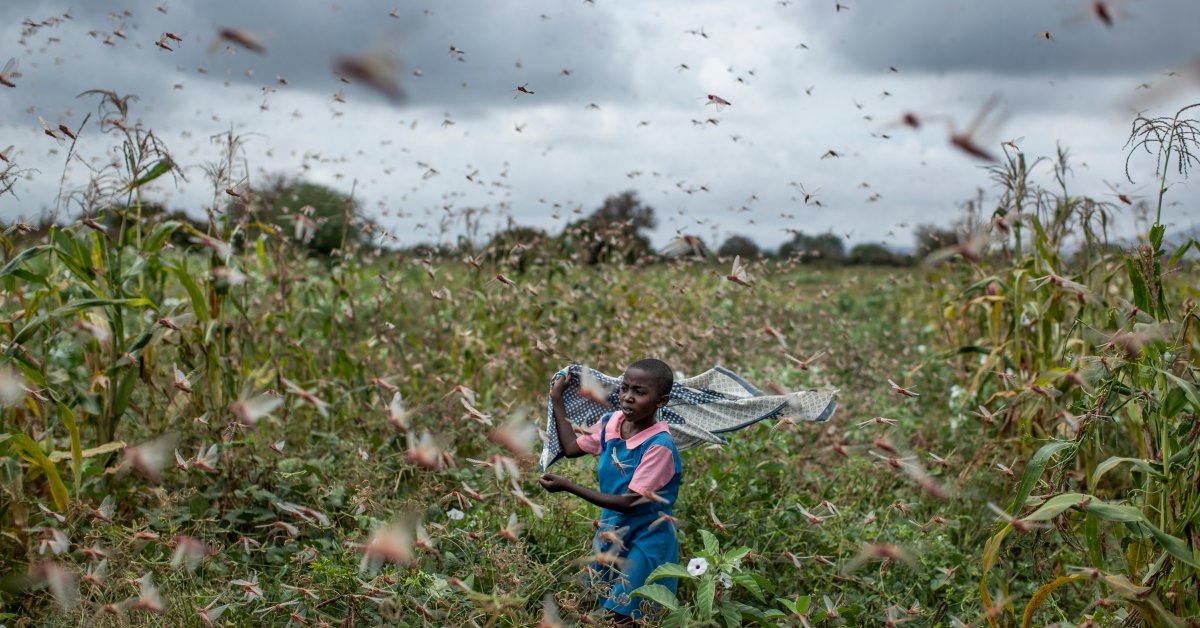
Translating…
(KATITIKA, Kenya) — The hum of thousands and thousands of locusts on the hasten is broken by the screams of farmers and the clanging of pots and pans. But their noise-making does diminutive to end the voracious insects from feasting on their crops in this rural community.
The worst outbreak of barren space locusts in Kenya in 70 years has considered hundreds of thousands and thousands of the bugs swarm into the East African nation from Somalia and Ethiopia. These two countries have not had an infestation fancy this in a quarter-century, destroying farmland and threatening an already vulnerable space with devastating hunger.
“Even cows are wondering what’s going on,” stated Ndunda Makanga, who spent hours Friday searching to lunge the locusts from his farm. “Corn, sorghum, cowpeas, they’ve eaten the total lot.”
When rains arrive in March and produce new vegetation across much of the distance, the numbers of the short-breeding locusts could well per chance grow 500 cases sooner than drier weather in June curbs their spread, the United International locations says.
“We have to act straight away,” stated David Phiri of the U.N. Food and Agricultural Group, as donors huddled in Kenya’s capital, Nairobi, a 3-hour drive away.
About $70 million is wished to step up aerial pesticide spraying, the handiest effective manner to wrestle them, the U.N. says. That won’t be straightforward, namely in Somalia, where components of the nation are in the grip of the al-Qaida-linked al-Shabab extremist neighborhood.
The rose-colored locusts flip total trees purple, clinging to branches fancy quivering adorns sooner than taking off in hungry, rustling clouds.
Astonished by the finger-dimension insects, kids plug right here and there, waving blankets or plucking at branches to shake the locusts free. One lady, Kanini Ndunda, batted at them with a shovel.
Even a cramped swarm of the insects can train ample food for 35,000 folks in a single day, stated Jens Laerke of the U.N. humanitarian space of work in Geneva.
Farmers are worried to let their cattle out for grazing, and their crops of millet, sorghum and maize are vulnerable, but there is diminutive they will attain.
About 70,000 hectares (172,973 acres) of land in Kenya are already infested.
“This one, ai! This is enormous,” stated Kipkoech Epic, a migratory pest control specialist with the agriculture ministry. “I’m speaking about over 20 swarms that now we contain sprayed. We composed contain extra. And extra are coming.”
A single swarm can personal up to 150 million locusts per square kilometer of farmland, an home the dimensions of nearly 250 football fields, regional authorities disclose.
One namely enormous swarm in northeastern Kenya measured 60 kilometers long by 40 kilometers vast (37 miles long by 25 miles vast).
Kenya wants extra spraying equipment to complement the four planes now flying, Epic stated. Ethiopia furthermore has four.
They furthermore need an on an habitual basis supply of pesticides, stated Francis Kitoo, deputy director of agriculture in southeastern Kenya’s Kitui county.
Earn The Temporary.Stamp in to bag the tip experiences it be considerable to know real now.

Thanks!
To your security, we now contain despatched a confirmation e mail to the address you entered. Click the link to substantiate your subscription and originate receiving our newsletters. Must you don’t win the confirmation internal 10 minutes, please verify your junk mail folder.
“The locals are in point of fact alarmed because they will train the total lot,” Kitoo stated. “I’ve never considered this form of immense amount.”
The locusts be pleased the fodder for animals, an predominant supply of livelihood for families who now grief how they’ll pay for charges fancy faculty charges, he stated.
His personal dispute about the locusts?
“They would possibly be able to lay eggs and originate one other skills,” he stated.
Aalteringclimate has contributed to “unparalleled” breeding stipulations, stated Nairobi-based climate scientist Abubakr Salih Babiker.
Migrating with the wind, the locusts can quilt up to 150 kilometers (93 miles) in a single day. They seek fancy exiguous plane lazily crisscrossing the sky.
They are in point of fact heading towards Uganda and fragile South Sudan, where nearly half the nation faces hunger because it emerges from civil battle. Uganda has not had this form of virus since the 1960s and is already on alert.
The locusts furthermore are transferring gradually towards Ethiopia’s Rift Valley, the breadbasket for Africa’s second-most populous nation, the U.N. says.
“The grief is incredibly coarse but farmers are stopping it in the mild manner,” stated Buni Orissa, a resident of Ethiopia’s Sidama space. “The locusts fancy cabbage and beans. This could per chance per chance presumably also threaten the shaky food security in the distance.”
Even sooner than this outbreak, nearly 20 million folks faced high levels of food insecurity across the East African space long challenged by periodic droughts and floods.
As enraged farmers seek extra lend a hand in stopping regarded as one of history’s most power pests, the FAO’sLocust Glimpseprovides diminutive comfort.
“Even though vast nets, flamethrowers, lasers and large vacuums had been proposed prior to now, these aren’t in use for locust control,” the U.N. company says. “Of us and birds in total be pleased locusts but in total not ample to seriously decrease population levels over enormous areas.”
Serene, it supplied recipes. One urged seasoning in Uganda is chopped onion and curry powder. Then fry.
___
Anna reported from Johannesburg. Frank Jordans in Berlin and Elias Meseret in Addis Ababa, Ethiopia, contributed.
Contact usateditors@time.com.

